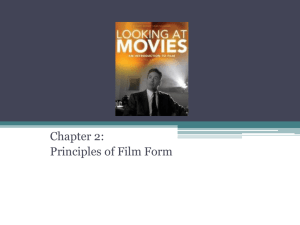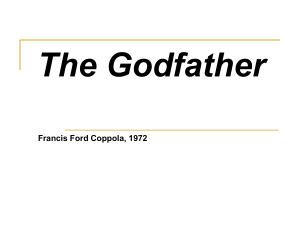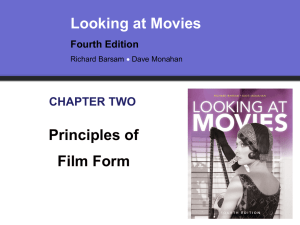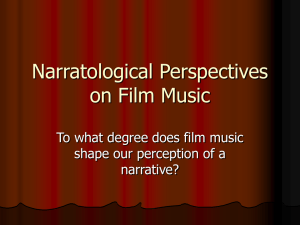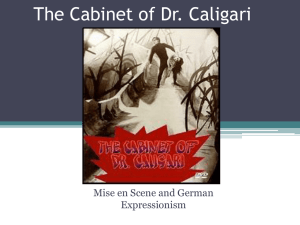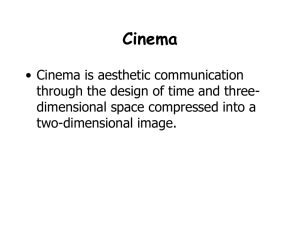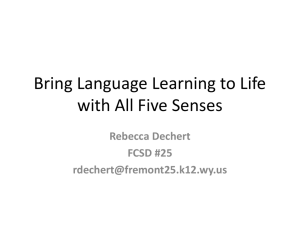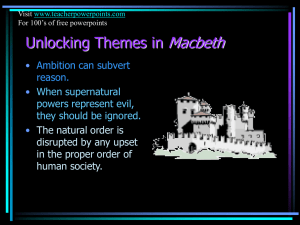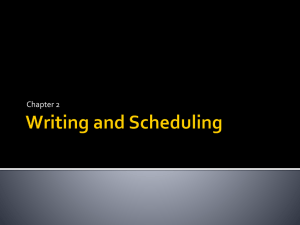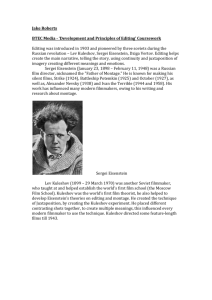Principles of Film 2
advertisement
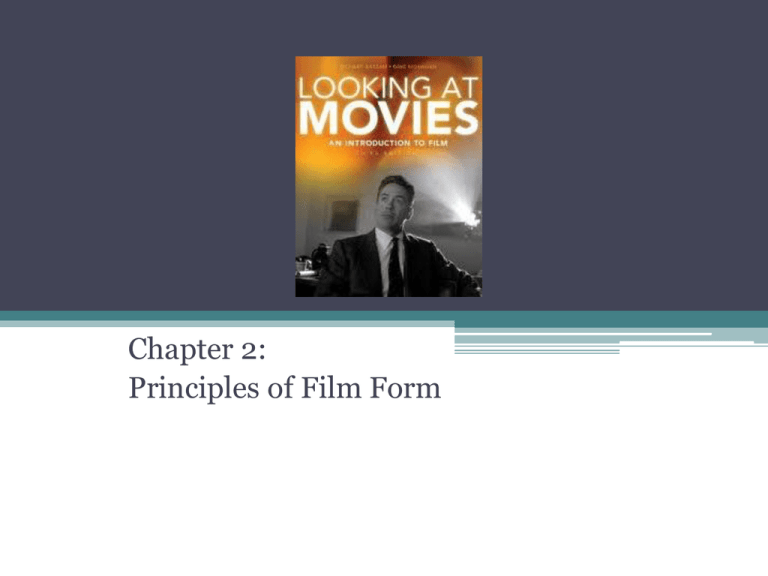
Chapter 2: Principles of Film Form Looking at Movies, Chapter 2 Objectives of this Presentation • You should be able to: • Differentiate between form and content and discuss how they are related. • Discuss the different ways expectations can shape your interpretation of a movie. • List some patterns commonly used in movies and discuss how these patterns create structure and convey meaning. • Define realism, antirealism, and verisimilitude. • Define cinematic language and apply it in practice. • Identify formal elements such as Mise en Scene, Sound, Editing, and Narrative Form and Content • Content is the subject of an artwork, while Form is the means by which the subject is expressed. • Consider the following images of humanity • They offer similar content but a wide variation in form The Walking Man, by Giacometti Michelangelo’s David Self- Portrait, by Keith Haring Don Quixote and Sancho Panza Toy Story 3, The Incredibles, Wall-E Sample Scene: Heist (2001) • Consider a bank robbery as viewed objectively and subjectively. • The objective view would be provided by the security camera on the wall. It is essentially devoid of form. Imagine watching the entirety of this scene from that single, fixed perspective. We would be able to see almost everything from the moment the thieves break in to the moment they leave a few minutes later. • The action would occur in real time: we would see everything the actors do in the sequence in which they do it. We would see this from a location far above and detached from the action. We will have witnessed content: the content of those minutes presented unfiltered. Form: Heist • From the minute the thieves arrive the film-makers use formal elements. • The scene’s action is broken into 81 shots which control what we see, how we see it, when we see it, how long we see it, and in what order we see it. • Some shots are shown from the perspective of one character, or none; we see reactions to actions. Close ups isolate and emphasize certain elements. Mise en Scene • Composes design elements such as • • • • light setting props costumes within individual shots Sound • • • • dialogue music ambient sounds sound effects Editing • juxtaposes individual shots • orders these juxtapositions into sequences, sequences into scenes, and scenes into movies • often relies on patterns and progressions to build story and engage viewer interest Common Editing Patterns • ABCABCABC • A= Woman tied to railway track • B= Hero racing toward woman in peril • C= On-rushing locomotive • (relies on parallel editing, which sustains the illusion that these events are happening at the same time) • ABABABAB (shot/reverse shot pattern) • A= First Stranger (on a train!) B= Second Stranger Common Editing Patterns, cont’d • AAAAAAAB • A=Scenes of Daily life in New England (Pocahontas) • B= Arrival of John Smith and the English settlers • AAAABAAABAABABABC • A= happy July 4th swimmers • B= hungry shark (cue the music!) • C= swimmers meat shark/shark meats swimmers Narrative: Patterns and Expectations • Narrative is structured into acts that establish, develop, and resolve character conflict • The audience often attends a film with certain expectations. • Perhaps we have enjoyed previous works by the director, the screenwriter, or the actors. • Perhaps the genre (romantic comedy, thriller, vampire melodrama with squinty female protagonist) appeals... Patterns: The Big Picture • In the broadest sense, film genre provides a pattern for a film. For instance, what do we expect when we go see • • • • • Romantic Comedies? Horror Films? Epics? Fantasy Films? Michael Bay movies? • Often genres provide us with a sense of expectation. As the film unfolds, we can judge the degree to which it conforms or breaks the conventional expectations of the genre. (More on genre later in the course!) Narrative, continued Many films strive for an element of verisimillitude, a quality that suggests a kind of reality. It doesn’t mean a film has to be realistic, but we need to be able to buy in and believe that in the world created by the film, the events that unfold are plausible. • We know dinosaurs aren’t real, but we believe that in the world of Jurassic Park, they are. • We start to form impressions very quickly once the movie begins, sometimes even as the opening credits roll. • Once the narrative begins, we ask questions about the story’s outcome, questions we will ask repeatedly and wait to have answered over the course of the film. Questions, Questions... • • • • • • • • Will Sheriff Brody capture the shark? Will Dorothy get back to Kansas? Will Frodo destroy the ring? Will the Corleone family go legit? Will we ever learn what rosebud is? Who is Keyser Soze? Will Juno keep the baby? Who killed (or will kill) Lester Burnham? Synthesis • The synthesis of all of these elemental forms • Mise en Scene • Editing • Sound • Narrative • (and others) constitutes the overall form that a movie takes Sample Scene: American Beauty(1999) • Within the first 5 minutes of the film, Lester tells us that he will be dead within a year. He also acknowledges that in some ways, he is dead already. As the film unfolds, numerous potential suspects emerge. • Within the first 10 minutes, however, Director Sam Mendes does far more than merely foreshadow Lester’s inevitable (?) death. • Consider the ways that Mendes portrays- largely through imagery and composition of shots- Lester’s entrapment in his daily life. • Look for shots, angles, and details that reinforce the idea of a trapped life, an insignificance, a feeling of impotence... a feeling of being dead already Screening Checklist • A useful initial step in analyzing any movie is to distinguish an individual scene’s content from its form. Try to first identify a scene’s subject matter: • What is this scene about? • What happens? • Once you have established that content, you should consider how that content was expressed. • • • • What was the mood of the scene? What do you understand about each character’s state of mind? How did you perceive and interpret each moment? Did that understanding shift at any point? Cinematic Space • Do you notice anything particular about the movie’s presentation of cinematic space—what you see on the screen? Lots of landscapes or close-ups? Moving or static camera? • What is the effect of this selection of detail? Lighting • Does the director’s use of lighting help to create meaning? If so, how? • Consider the role of light and dark, sunlight and shadow, under-exposure and over-exposure The Night of the Hunter- “Leaning” • Consider the role of lighting in the development of this scene. • Where does danger lie in this scene? Who is in danger? • Where does the hope of salvation lie? • How does lighting contribute to this effect? • Consider the duet sung by the preacher and the grandmother. What does it add to the scene? Manipulation of Time • Does the director manipulate our experience of time? • Is this condensing, slowing, speeding, repeating, or reordering of time simply practical (as in removing insignificant events), or is it expressive? • If it is expressive, just what does it express? The Godfather- “Baptism and Murder” • This scene presents an excellent example of the manipulation of time. Coppola cuts between the baptism of Michael’s son, the preparation for 5 murders, and the murders themselves. • Each time we return to the baptism, it continues where it left off, establishing that these actions are happening simultaneously. Furthermore, it establishes Michael’s involvement in them. • Music also adds an element of continuity, rising as the sequence progresses. Narrative Patterns • Do any narrative or visual patterns recur a sufficient number of times to suggest a structural element in themselves? • If so, what are these patterns? • Do they help you determine the meaning of the film? The Camera Lens and You • Do you identify with the camera lens? • What does the director compel you to see? • What is left to your imagination? • What does the director leave out altogether? • In the end, besides showing you the action, how does the director’s use of the camera help to create the movie’s meaning? Film Form • A movie is highly organized and deliberately assembled and sculpted by a film-maker from various elements including • • • • Mise en Scene Sound Editing Narrative Formal Elements of Cinematic Language Once you know what happened and how you felt about it, search the scene for those formal elements that influenced your interpretation and experience. The combination and interplay of multiple formal elements that you seek is the cinematic language that movies employ to communicate with the viewer. Sample Exercise: Opening Credits • Consider the following 2 credit sequences And these 2... The Shawshank Redemption (1994) • Based on the Stephen King novella “Rita Heyworth and the Shawshank Redemption” • Released in 1994 to critical praise but audience indifference, making back only 18M of its 25M budget • Nominated for 7 Academy Awards • Won none! (Forrest Gump/Pulp Fiction) Redemption, indeed... • Since then, the film has become one of the most beloved of all time • On the IMDB reader’s poll of 250 favourite films of all time, it currently ranks 1st, with a score of 9.2 (tied with The Godfather, but with more votes) • Everyone who makes a movie hopes to achieve a kind of alchemy, in which baser materials are turned into gold. The Shawshank Redemption achieves this feat.
